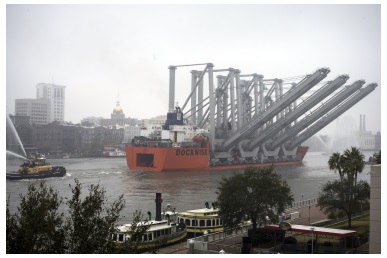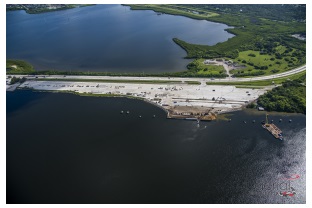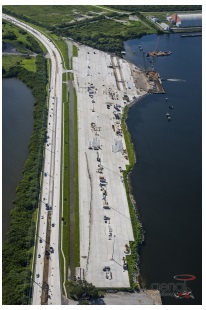Terminal Operations: Savannah, Tampa
![]() Print this Article | Send to Colleague
Print this Article | Send to Colleague
Four New Super post-Panamax cranes arrive at the Port of Savannah

Boskalis vessel Teal sailing up the Savannah River December 5 with four new ship-to-shore cranes for Garden City Terminal
Photo/Stephen B. Morton, Georgia Ports Authority
Four new Super Post Panamax ship-to-shore cranes arrived December 5 at Georgia Ports Authority’s Garden City Terminal, bringing the Port of Savannah's total to 26.
The new cranes can span vessels 22 containers wide.
"We're growing our crane fleet in order to stay ahead of demand," said GPA Chief Operating Officer Ed McCarthy. "Since the opening of the expanded Panama Canal in June, Garden City Terminal has seen a 40 percent increase in the number of vessels carrying 8,000 or more twenty-foot equivalent container units. Over the same period, the Port of Savannah has seen a 21 percent increase in the number of TEUs handled per vessel."
Counting the new arrivals, Savannah is now equipped with 20 neo Panamax cranes and six post-Panamax cranes (reaching 17 containers across). Another four neo- Panamaxers are due for delivery to Savannah in 2018. The cranes operate along nearly 10,000 feet of contiguous berth space.
"For customers, it means the capacity to move up to a thousand containers per hour across a single dock at America's largest terminal - allowing us to work more vessels, more quickly," said Georgia Ports Authority Executive Director Griff Lynch. "It means getting cargo to market and getting ships back out to sea with unmatched efficiency."
Tampa Bay Opens New East Port cargo berth 150
Port Tampa Bay announced December 8 the opening of a new, multi-use cargo berth in an area known as East Port. Sited on 20 man-made acres and featuring 14-inch reinforced concrete, the all-purpose berth and upland can handle container, ro/ro and bulk cargo.
Phase 1 of the East Port project, which started in 2012 and ended in 2013, entailed construction investment of approximately $4.6 million, which included necessary mitigation. Phase 2 was completed in August 2016 for approximately $21 million, half of it financed by the Florida Department of Transportation and the balance by the port authority.
"Today is a very significant moment in Port Tampa Bay’s history and in its business development profile," said Port Tampa Bay CEO Paul Anderson. "With these new cargo berths will come fresh import and export prospects and new partners for the state’s largest port, as well as new jobs and generational impacts that will have lasting, positive effects for our region."


Views of the new Eastport cargo berth 150, at Port Tampa Bay
Photos/Port Tampa Bay

